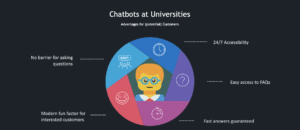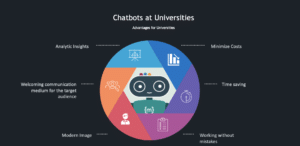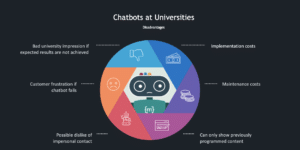Chatbots at universities – these are the pros and cons
This is why universities and colleges should also embrace the use of chatbots!
As part of their studies in Digital Management (MA.), students Antonia Biel, Simone Schreiner and Fabian Wanner took a detailed look at the topic of chatbots and identified various advantages and disadvantages for universities. The following provides a brief insight into the results of their work.
Chatbots provide intelligent customer service
“Chatbots are key in your organization’s digital journey and in delivering next generation intelligent customer service,”(1) says Naser Bakhshi, Senior ManagerAdvanced Analytics and AI Lead at Deloitte Digital. According to IBM Cloud Education, a chatbot is a computer program that uses AI and natural language processing (NLP) to automate responses to user queries and simulate human conversations. Chatbots can help users find the information they need more easily(2).
Use of chatbots
Studies show chatbots are already increasingly used today. Around 80% of the participants surveyed have already used a chatbot. Of those respondents who had never used a chatbot, around 75% were over the age of
45 years old. Based on this, it is clear that younger generations are particularly open to new technologies and the trend topic of chatbots (3).
Advantages for universities
Through digitization and the use of chatbots, colleges or universities can optimize their workflows. This applies on the one hand to processes that take place in the background, and on the other hand to communication with their target group.
Source: moinAi Avatar
A closer look shows that potential students particularly benefit from unrestricted accessibility “24/7” through the use of chatbots. Applicants can find the information they are looking for about the respective university or about the degree programs very quickly and easily. People who live in a different time zone, or who are looking for specific information at times when no contact person at the university is available, will especially benefit from this service. Another benefit is the ease of access to university information. With one click and quick conversations, potential customers are encouraged to actively search for information. Accordingly, chatbot users can receive answers many times faster than when communicating via email, for example. Moreover, communication via digital tools such as chatbots has long been established in modern society. Therefore, this type of medium is very welcome for the target group of universities. In addition, the possible existing barrier of asking questions in person on the phone is eliminated.
Source: moinAi Avatar
For universities, on the other hand, a chatbot also offers some notable advantages. For one, implementation can reduce marketing department costs. By answering multiple questions at the same time, chatbots help eliminate staff and support costs. Consequently, this is also very time-saving for employees, as they are relieved from answering repetitive questions and can spend more time on other tasks. On the other hand, if a chatbot is programmed “correctly”, it works without errors. Another significant advantage is that the modern and innovative image of the university is strengthened and it stands out from the competition. The marketing department also benefits above all from the analytical insights that a chatbot can provide: Numbers, data, facts about the number of chats, their duration and content, frequently asked questions, and much more (4).
Disadvantages for universities
However, there are also a few disadvantages that can be identified for universities when using chatbots (4). For one, there are implementation costs. Since a chatbot can only show and answer the content that has been programmed for it, it must be maintained and expanded in order to remain up to date. This results in ongoing costs. If the chatbot were to show potential customers the wrong content or not have an answer to their questions, this could lead to a negative impression of the university and frustration on the part of the users. On the other hand, there is the possibility that the target group might refuse to use a chatbot or might not feel comfortable with an impersonal contact.
Sources listed above:
(1) Bakhshi, N., 2018, Chatbots Point of View – Deloitte Artificial Intelligence. Link: https://www2.deloitte.com/content/dam/Deloitte/nl/Documents/deloitteanalytics/deloitte-nl-chatbots-moving-beyond-the-hype.pdf.
(2) IBM Cloud Education, 2019, Chatbots. Link: https://www.ibm.com/cloud/learn/chatbots-explained.
(3) Userlike, 2020, Neue Studie: Was Ihre Kunden wirklich über Chatbots denken. Link: https://www.userlike.com/de/blog/kunden-chatbotsstudie#:~: text=Fazit%20zur%20Kundenwahrnehmung%20von%20Chat bots&text=Ihre%20schnellen%20Antworten%20und%20die,einen%20T eil%20der%20Arbeitslast%20abnehmen.
(4) See also for AI Chatbots and the avatar in the graphs https://www.moin.ai/



